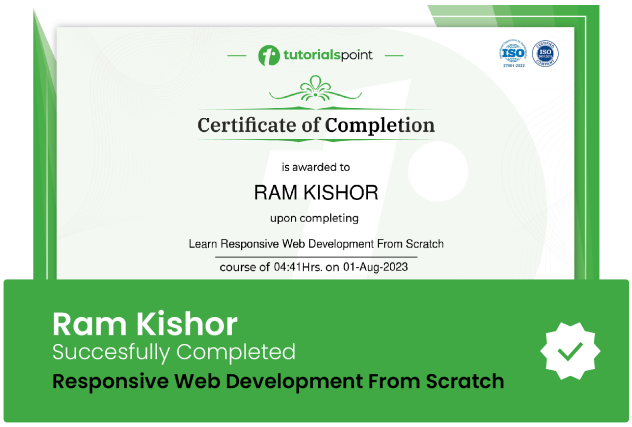AJAX API JSON Connect to JSON data using AJAX webpage
JavaScript for beginners JavaScript Objects and JSON data for web pages AJAX request for JSON data to use in JavaScript

Lectures -21
Resources -1
Duration -1 hours

30-days Money-Back Guarantee
Get your team access to 10000+ top Tutorials Point courses anytime, anywhere.
Course Description
JavaScript Object Notation (JSON) is an open-standard file format or data interchange format that uses human-readable text to transmit data objects consisting of attribute–value pairs and array data types. It is a very common data format, with a diverse range of applications.
JSON is a language-independent data format. It was derived from JavaScript, but many modern programming languages include code to generate and parse JSON-format data. The official Internet media type for JSON is application/json. JSON filenames use the extension .json.
AJAX ("Asynchronous JavaScript + XML") is a set of web development techniques using many web technologies on the client side to create asynchronous web applications. With Ajax, web applications can send and retrieve data from a server asynchronously (in the background) without interfering with the display and behavior of the existing page. By decoupling the data interchange layer from the presentation layer, Ajax allows web pages and, by extension, web applications, to change content dynamically without the need to reload the entire page.
In practice, modern implementations commonly utilize JSON instead of XML.
Course Covers
JavaScript Objects and how they are used in code to retrieve values and store groups of related data sets
JavaScript Arrays - a data structure commonly used in JSON to contain Objects
JSON vs JavaSCript Objects
Iterate Array Contents
JSON parse and Stringify
Tools online to help connect to endpoints and debug AJAX requests
Use of JavaScript Fetch to return content
GET and POST methods to web endpoints
Various examples of open web APIs
Source Code is included.
Who this course is for:
- Web designers
- Web Developers
- Anyone who is building a website
- Webmasters and web coders creating web content
Goals
What will you learn in this course:
- How to use JavaScript Objects
- How to use JSON data
- Explore JavaScript
Prerequisites
What are the prerequisites for this course?
- JavaScript
- Programming and coding knowledge
- HTML and some programming experience

Curriculum
Check out the detailed breakdown of what’s inside the course
Introduction
20 Lectures
-
API JSON Introduction 02:28 02:28
-
Course Resources
-
Introduction to JSON 03:34 03:34
-
JavaScript Objects 05:31 05:31
-
JavaScript Arrays 02:27 02:27
-
Output Contents 03:14 03:14
-
JSON Stringify JSON Parse 03:01 03:01
-
Validate lint JSON 03:05 03:05
-
JavaScript Fetch AJAX request 04:05 04:05
-
Fetch Web APIs AJAX from web pages 02:36 02:36
-
JavaScript Arrow Function format 01:55 01:55
-
Fetch Options GET 03:04 03:04
-
CORS with request debugging 02:28 02:28
-
More Open APIs Practice 03:23 03:23
-
Fun with APIs Tools and More 04:35 04:35
-
API Next Page Load all pages 05:31 05:31
-
Post method send data 03:26 03:26
-
Practice API endpoints 04:49 04:49
-
More API endpoints AJAX request Exercise and JSON data 04:13 04:13
-
API JSON conclusion 03:20 03:20
Instructor Details

Laurence Svekis
eCourse Certificate
Use your certificate to make a career change or to advance in your current career.

Our students work
with the Best


































Related Video Courses
View MoreAnnual Membership
Become a valued member of Tutorials Point and enjoy unlimited access to our vast library of top-rated Video Courses
Subscribe now
Online Certifications
Master prominent technologies at full length and become a valued certified professional.
Explore Now



 Updated on Apr, 2024
Updated on Apr, 2024
 Language - English
Language - English